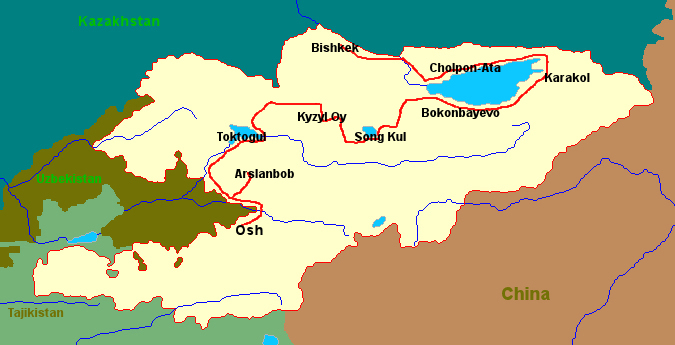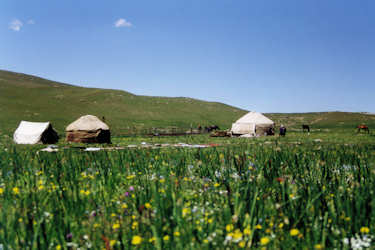Kyrgyzstan

Historie
Central Asia and the areas around the Tian Shan have been inhabited for thousands of years, as petroglyphs and archaeological finds can
attest. Some of the earliest settlers were nomadic pagans who practiced Tengrism, an ancient monotheistic religion centered around nature.
Up until the Battle of Talas, between the Chinese Tang dynasty and the Arab Abbasid Caliphate in 751 CE, Central Asia was
a largely Buddhist territory, though certainly other religions and cultures were well known because of travelers on the Silk Road.
The Battle of Talas marked a turning point, from which Islam starting becoming the dominant religion and influence on the region.
The Karakhanids were one of such early Muslim dynasties, and they mixed many older Turkic elements with Islam. The Karakhanids were in
power from the 9th to 11th centuries, during which time they built Burana Tower (all thatís left of their capital, Balasagun) and
the mausoleums in Uzgen.
Starting in the 13th century, with the Mongol conquest sweeping across Asia, the people that became todayís ethnic Kyrgyz moved from the Yenisei
River, in Siberia, to their current home in the Tian Shan.
The Tian Shan remained under the control of the Mongols in various forms for several hundred years, including under the Kalmyks, the
Oirats, and the Dzungars, depending on who had recently beaten whom.
The Manchu (Qing) defeat of the Oirats in 1758 left the Kyrgyz as de facto subjects of the Chinese, who mainly left them to their nomadic
ways.
In the 18th century the feudal tentacles of the Kokand khanate, began to encircle them, though the fiesty Kyrgyz constantly made trouble
from there Tian Shan redoubts.
Central Asia was right in the middle of the "Great Game" of imperial expansion in the 1800s, played out between Russia from the north
and Great Britain from the south. At this time, the Khanate of Kokand was much weaker, and so smaller regional rulers had significantly
more power.
When Alimbek Datka, who was the ruler of the Alai (in what is now southern Kyrgyzstan), was murdered in a palace coup, his wife, the
strong Kurmanjan, became the newest leader in 1862.
As the Russians moved closer and closer, Kurmanjan Datka urged a peaceful transition, and in 1867, the Alai region was annexed by the
Russian Empire.
On August 31, 1991, the Republic of Kyrgyzstan declared independence from the Soviet Union.
The president since 1990, Askar Akayev, became President of the new republic, and stayed in office until the Tulip Revolution in 2005.
I visited Kyrgyzstan in july 2001
On that trip i have seen
Osh
Arslanbob
Toktogul
Kyzyl Oy
Song Kul
Bokonbayevo
Karakol
Cholpon-Ata
Bishkek
Please let me know when you're having questions.
i would be pleased to help you.
Things to do and other tips
